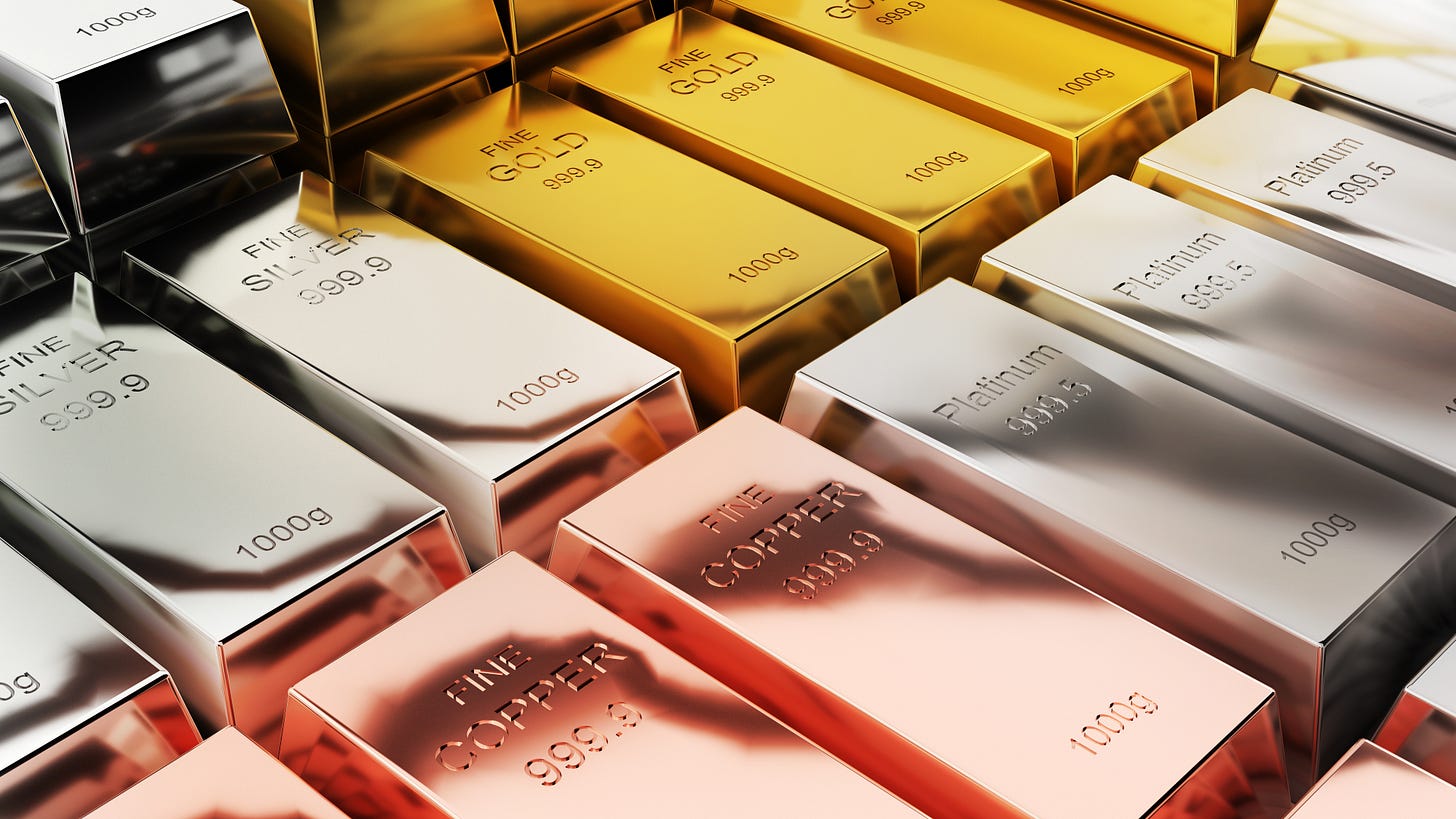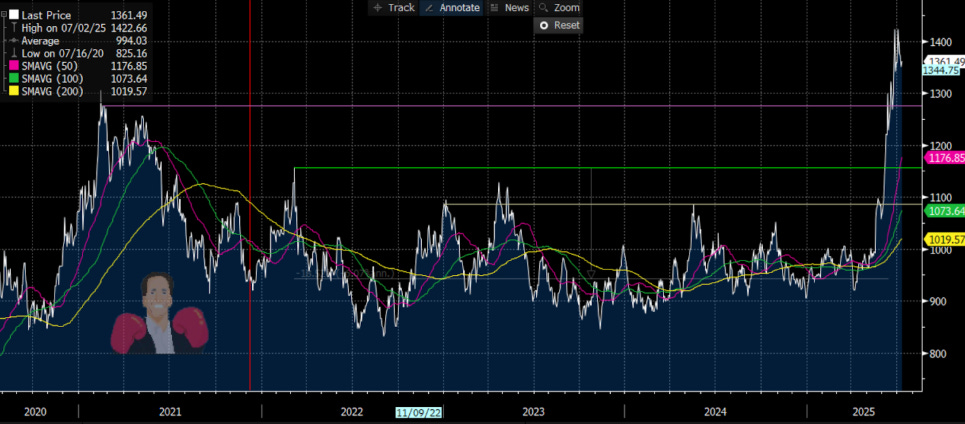Making Hay Monday - July 14th, 2025
Beyond Bullion: The Rise of the Industrial Metals
Gold: Not The Only Metal Shining These Days
"If you want to be a conduit for God's grace, you don't have to be lined with gold. Copper will do." -John Piper (He could have said platinum, too)
"The quick summary of (the bull story on platinum) is primary supply is in trouble at -6% YOY...industrial demand could easily surprise to the upside...So I don't think it's a stretch to think we get a big move in the next year or so." -Trader Ferg in an email to me on 5/31/25 just prior to a 38% platinum price rally
There is an oddity I’ve previously written up: the massive discount platinum trades at versus gold. This remains the case even after the upside eruption the former has had after we fortuitously put out a Trading Alert “Buy” on it back on March 12th. As you can see below, it’s been quite the vertical spurt.
Five-year Price Chart of Platinum
Unquestionably, this is one hyperextended commodity right now. As a result, it is ripe for a meaningful retracement. But you may notice from the three colored horizontal lines that at around $1,100 it first broke resistance. (Admittedly, there was a bit of a head fake in late 2022 when it briefly and indecisively poked above $1,100.) Shattering resistance at $1,170 was the next green light.
Previously, this had held for almost three years (again, three years is our critical timeframe for determining if range expansions are significant). Taking out the 2020 high in the $1,300 vicinity was the next highly bullish development.
The next hurdle is around $1,700 where it triple-topped in 2012 and 2013 (not shown). Further back, the all-time high (ATH) was around $2,270 in 2008. That’s a long way from its current price of $1,360 or so, but I believe it will take that out in the next year or two (okay, maybe three). Naturally, there will be a lot of zig-zagging on the way to making a new ATH but given the staggering amount of fiat-currency fabrication that has occurred this decade, I think that’s an attainable long-term target.
This leads to the oddity I mentioned at the outset. Platinum traded well above gold for so long that some credit card companies, and other prestige branding entities, labeled their top-tier offering as platinum, not gold.
At its 2008 ATH, platinum was double gold’s price. Yet, even after white gold’s muscular rally of late, it is selling for less than half of bullion’s value.
My overarching/macro view is that metals which also have industrial applications – such as platinum, copper and silver – have a massive amount of catching up to do vis-à-vis gold. This is not to dismiss the reality that central banks are in the midst of a turbocharged rotation out of U.S. Treasury bonds as their reserve asset of choice and into gold. No such multi-trillion-dollar buying power exists for metals like platinum and copper.
On the other hand, silver and copper have proliferating demand coming from surging military spending around the world. The need to restore robustness to the U.S. electrical grid is another brawny supporting factor for increased usage of both metals. In the case of platinum, the realization that hybrids are where the most rapid EV growth is occurring represents another powerful demand driver. (Hybrids use far more platinum than do EVs and even, in certain cases, more than in internal combustion engines; however, palladium remains my preferred way to play the hyper growth in hybrids.)
As many have pointed out, wars are expensive and inflationary. They also have been consistently beneficial to the pricing for critical commodities. The amount of rebuilding that needs to occur in countries like Ukraine and Iran, as well as regions such as Gaza, is likely to generate enormous demand for many industrial metals, particularly copper, aluminum, and steel.
Further, it’s my contention that investors who control trillions of dollars are awakening to the fact that “rich country” bonds are increasingly certificates of confiscation. In simplistic terms, this means that inflation in most Western countries is likely to wipe out any cash-flow yield, particularly after taxes are also taken into account. (The Trump administration is threatening to tax foreign holders’ interest on U.S. bonds.) In fact, the inflation-adjusted returns are likely to be negative, at least in countries prioritizing growth over the integrity of their currency. The U.S. may be leading this ignominious charge.
A tangible example of this is that Donald Trump is brazenly pushing for the next Fed chairman to be an easy money proponent. Accordingly, if Mr. Trump gets his way, the person who replaces Jay Powell next May will have a propensity to drastically reduce short-term interest rates. If so, this is nearly certain to fan the inflationary embers which are still smoldering. As a result, U.S. Treasury (UST) yields net of inflation may once again go negative. That’s adverse for long-term fixed income instruments but a source of nearly irresistible buoyancy for hard assets like platinum, copper, and silver.
It's now time to segue into specific stocks that should benefit if the above IMAX view of the commodity world is in the area code of correct.




